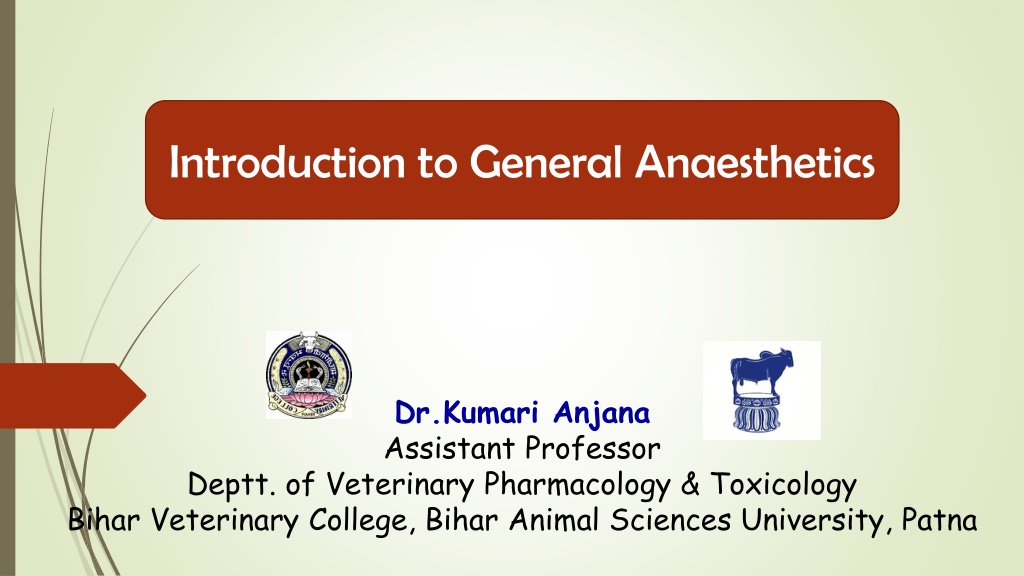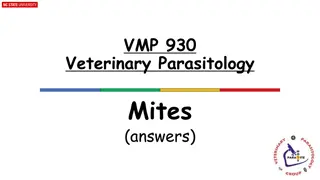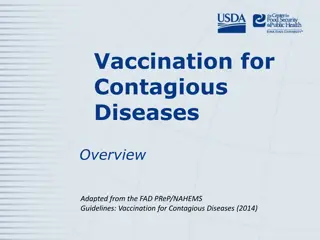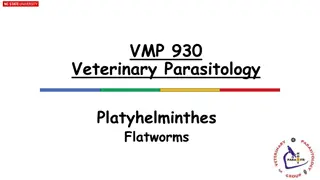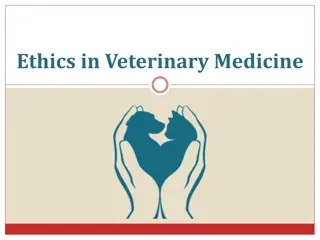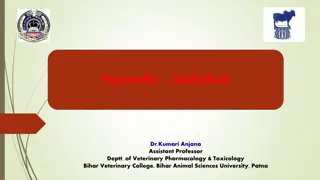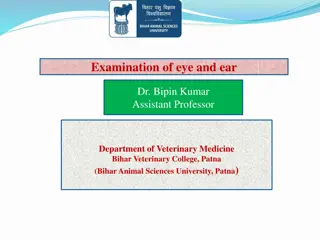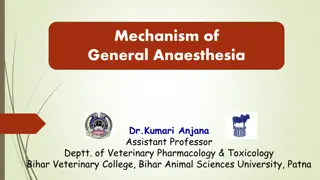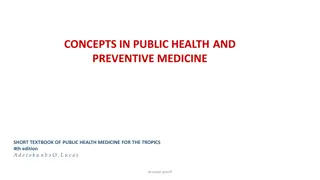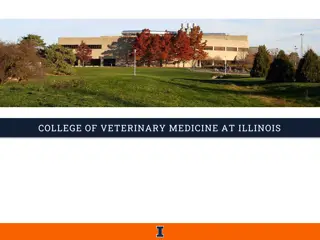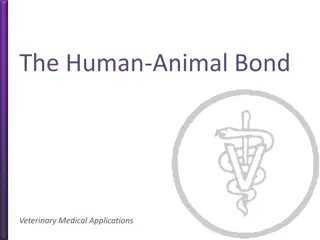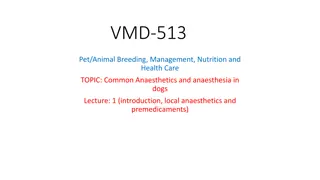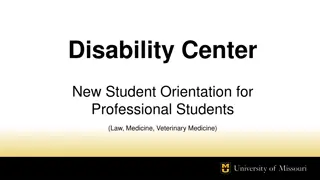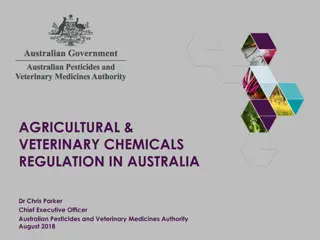General Anaesthetics in Veterinary Medicine
General anaesthetics induce reversible loss of sensations and unconsciousness, crucial for effective animal surgery. The use of a combination of drugs is essential to achieve safe and rapid effects in balanced general anaesthesia. Large animals present challenges due to their anatomy, making them unfit for general anaesthesia. Regional anaesthesia and neuroleptanalgesics offer alternative approaches for specific surgical needs while maintaining the animal's comfort and safety.
Download Presentation

Please find below an Image/Link to download the presentation.
The content on the website is provided AS IS for your information and personal use only. It may not be sold, licensed, or shared on other websites without obtaining consent from the author.If you encounter any issues during the download, it is possible that the publisher has removed the file from their server.
You are allowed to download the files provided on this website for personal or commercial use, subject to the condition that they are used lawfully. All files are the property of their respective owners.
The content on the website is provided AS IS for your information and personal use only. It may not be sold, licensed, or shared on other websites without obtaining consent from the author.
E N D
Presentation Transcript
Introduction to General Anaesthetics Dr.Kumari Anjana Assistant Professor Deptt. of Veterinary Pharmacology & Toxicology Bihar Veterinary College, Bihar Animal Sciences University, Patna
Introduction to General Anaesthetics General reversible loss of all sensations and unconsciousness. anaesthetics are drugs that produce The cardinal signs of general anaesthesia are: Loss of all sensation, especially pain Sleep (unconsciousness) and amnesia Immobility and muscle relaxation. Abolition of somatic and autonomic reflexes
Introduction to GA contd No single drug is capable of achieving these effects rapidly and safely. Rather anaesthesia, these effects are achieved by using combination of drugs, each drug for a specific purpose. in the modern practice of balanced General anaesthesia is generally employed in small animal surgery, but not usually recommended in large animal.
Introduction to GA contd Large animals are considered unfit for general anaesthesia: In recumbent position of animal, the voluminous rumen or stomach contents may enter in respiratory tract due to regurgitation and The distended rumen (accumulation of gases) presses on diaphragm causing respiratory distress and The vena cava reducing venous return resulting in reduced cardiac output (cardio- vascular insufficiency).
Regional anaesthesia: Reversible loss of sensations of a large portion/area of the body (pelvic or abdominal region) without consciousness. affecting the Surgical Anaesthesia: A state of anaesthesia under which the animal is in normal deep sleep, without responding to painful operations can be carried out without causing pain to the animal. stimuli, and surgical
Neuroleptanalgesics Combinations of tranquillizers (neuroleptics) and opioids called neuroleptanalgesics. A state of CNS depression and analgesia that may cause dramatic behaviour modification aggressiveness in animals. The most common combination is that of fentanyl and droperidol. The cardiopulmonary functions should be closely monitored when neuroleptanalgesics are used as these drugs may produce respiratory or haemodynamic depression ranging from slight to significant. and change in
Basal Anaesthetics Agents which produce a lighter level of anaesthesia (basal anaesthesia), not suitable for surgical procedures, helps in restraining the animal. Animal is unconscious yet responds to painful stimuli. Basal anaesthesia is often induced before patient goes into the operation theatre. Agents : Chloral hydrate, pentobarbitone and diazepam In some cases, basal anaesthesia can even be produced by use of pre-anaesthetics. xylazine, paraldehyde,
Balanced Anaesthesia The general anaesthesia involves two phases i.e., induction and maintenance. These can be achieved by use of either a single anaesthetic agent or more than one agents. Except for short minor surgical procedures, the use of a single agent has been superseded by combination of two or more agents to take advantage of their desirable effects (e.g., speed of induction, skeletal muscle relaxation, depth and duration of anaesthesia), while simultaneously minimising their undesirable effects (e.g., respiratory hepatotoxicity). This practice of using two or more anaesthetics together with or without supplementary medications is called basal anaesthesia. depression, hypotension and
Preanaesthetic medication It consists of administration of certain drugs (for specific purpose so as to produce balanced anaesthesia) before General anathesia. The drugs generally used as preanaesthetics are Sedatives, Tranquillizers, Anticholinergics (muscarinic blockers) and Muscle relaxants. Analgesics, They are administered about 30 minutes prior to induction of anaesthesia.
Preanaesthetic medication contd Classification of Preanaesthetics: Preanaesthetic skeletal muscle relaxants: d-Tubocurarine, Gallamine. Preanaesthetic sedatives- (Pethidine), Diazepam, Morphine, Butorphanol. Preanaesthetic sedative antiemetic Acepromazine, Chlorpromazine. Preanaesthetics that diminish salivation and bronchial secretions especially during inhalational anaesthesia and to prevent cardiac arrest. Atropine, Glycopyrrolate. Xylazine, Meperidine
Classification of general anaesthetics Based on route of administration 1. Inhalation Anaesthetics 2. Parenteral Anaesthetics or Injectable 3. Dissociative Anaesthetics
